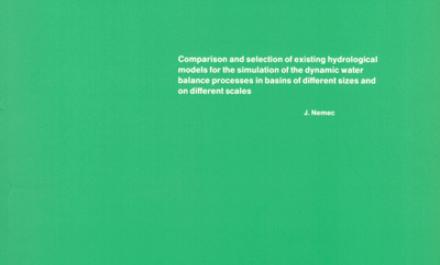Table of contents
| Preface | |
1. |
Introduction |
2. |
Validity of the conclusions of the study |
3. |
Classification and inventory of models |
| 3.1 | Models and procedures |
| 3.2 | Classification according to model application and purpose |
| 3.3 | Classification in terms of the type of the system |
| 3.4 | Classification in terms of hydrological processses or related variables |
| 3.5 | Classification in terms of causality |
| 3.5.1 | Deterministic models |
| 3.5.2 | Stochastic models |
| 3.6 | Relationship of deterministic and stochastic models |
4. |
Time and space discretization in hydrological modelling |
| 4.1 | Time discretization |
| 4.2 | Space discretization |
| 4.3 | Distributed models |
| 4.4 | Lumped models |
| 4.5 | Semi-distributed models |
| 4.6 | Sub-areas of semi-distributed models |
| 4.7 | Dimensions of surface water models |
| 4.8 | Criteria for selection of space discretization |
| 4.9 | Geographic Information Systems (GIS) |
5. |
Estimation of grid values from spatially distributed data |
| 5.1 | Gridding of climatic variables and parameters |
| 5.2 | Gridding of hydrological variables and parameters |
| 5.3 | Global Runoff Data Center |
| 5.4 | Physically based models |
6. |
Processes and sub-processes included in models |
| 6.1 | Vertical and horizontal structure of the processes and two level modelling |
| 6.2 | Two level modelling |
| 6.3 | Flow modelling |
| 6.4 | Evapotranspiration |
| 6.5 | Composition of processes in a model |
| 6.6 | Typical composition in conceptual models |
| 6.7 | Physically based models lead to distributed parameters |
| 6.8 | Rationale for semi-distributed models |
| 6.9 | Examples of semi-distributed models |
| 6.10 | Problems of scales |
| 6.11 | Use of remote-sensed data |
7. |
Selection of the type of model |
| 7.1 | Meso-scale model |
| 7.2 | Availability of models corresponding to the selected type |
| 7.3 | Description of the WMO inventory of models |
8. |
Recommendation concerning application of identified models |
9. |
Development of a macroscale physically based model |
10. |
Acknowledgements |
11. |
Summary - Résumé - Zusammenfassung - Samenvatting |
12. |
References |
Appendix 1: Models available as HOMS - components |
|
Appendix 2.1HYDROTEL Model |
|
Appendix 2.2: EGMO System |
|
Appendix 2.3: WATBAL System |
|
Publications of the CHR |
|
Some information on the CHR (German, French, English, Dutch) |
Sponsored reports
